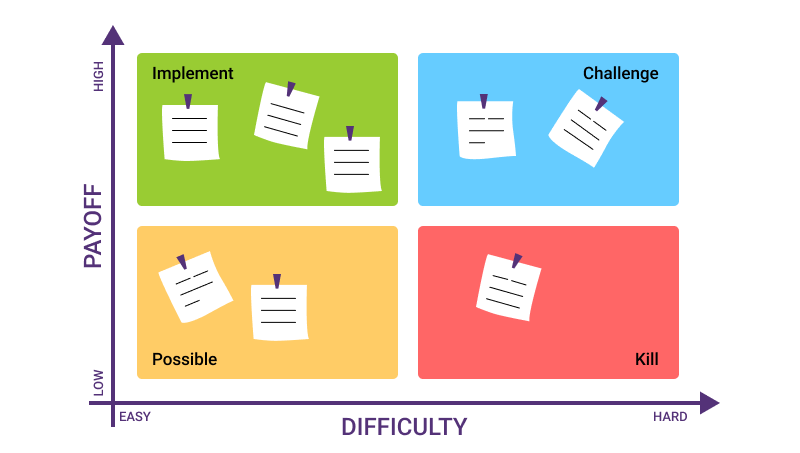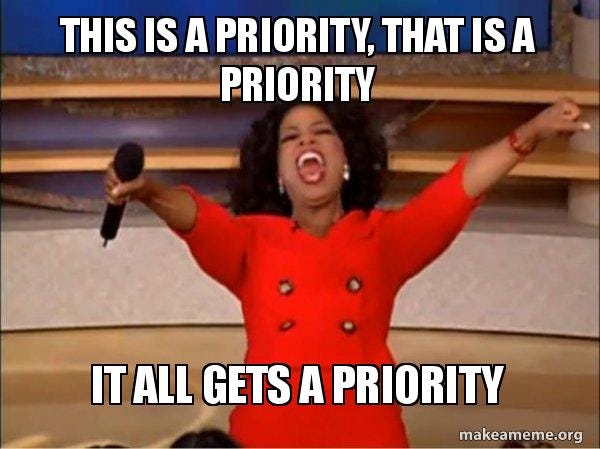Transform Your Analytics Career: Stress Less, Achieve More
Why the PICK Matrix is Your Secret Weapon for Sustainable Productivity
Check my Data Product Management playlist to read more about building successful data products.

Did you know a staggering 79% of employees are burdened by work-related stress?
That's not a random number; it's from a 2021 American Psychological Association survey. Nearly 8 in 10 of your colleagues could be wrestling with the same stress you feel. You're far from alone on this rocky road.
So, what's the ultimate fix for your stress?
Here's the twist:
It's not about waving a magic wand; it's about wielding a well-crafted game plan.
In the next few minutes, we're busting some big myths about work stress. I'll tell you about a tool that's as practical as a Swiss Army knife in solving this puzzle.
So, are you ready to transform from just another statistic into a change-maker?
Buckle up; we're diving into stress-busting solutions.
What Most People Think
You're balancing EL pipelines, data viz tasks, and dbt models—all to hit several deadlines.
Sounds like a typical Tuesday, doesn't it?
There's this prevailing belief that multitasking across different projects is the golden ticket to productivity in the data and analytics world. You might think more code, more queries, and more dashboards make you the team MVP.
But let's get real for a second:
When was the last time you felt genuinely productive while toggling between Python scripts, SQL queries, and team meetings?
If you're nodding along, thinking, "That's me! I'm doing it all!" let's hit the pause button. You're spreading yourself too thin, and you know it.
It's like being a one-person band. You might manage to play all the instruments, but you can't compose a symphony. No one's going to cheer for a disjointed tune. And the same holds for your data projects. Instead of actionable insights or efficient pipelines, you get bugs, bottlenecks, and, most importantly, burnout.
Multitasking and overcommitting — these aren't your tickets to success; they're your fast passes to professional fatigue.
Curious to see how this plays out?
Why This Approach Is Wrong
In data and analytics, the unwritten rule is that you should constantly be cranking out work. It's not about the hustle culture; it's more about the invisible yardstick that measures your worth by your output.
But here's the harsh truth:
Quality takes a back seat when you're juggling multiple tasks at once.
When you're thinly spread across multiple projects, you're doing just enough to keep the boat from sinking — but you're not steering it anywhere meaningful. Sure, you're delivering projects. Checkmarks are going into boxes. But take a moment and ask yourself:
How good are these projects?
Are they something you'd proudly put in your portfolio, or just a makeshift raft that barely floats?
And the cost of subpar work could be your job.

Imagine you're a chef, but all you have time for is to microwave pre-packaged meals. Sooner or later, people will notice the food doesn't taste quite right. In a competitive landscape, delivering poor-quality work can be a fast track to the exit door.
And here's where it gets even darker:
You're worried about job security, and, guess what, you're on a crash course with burnout. It's not some future risk; it's a ticking time bomb. You can keep going for a while, but eventually, you'll grind to a halt, completely worn out.
But hey, don't despair. We're not just identifying the problem; we're going to solve it. Coming up, we'll introduce you to a smarter way of working that keeps you sane without sacrificing quality.
What To Do About It
Ever heard of the PICK Matrix?
It stands for Prioritize, Implement, Consider, and Kill. Trust me, it's your new best friend in the quest for sanity and effectiveness. Let's break it down.
Prioritize tasks that are both urgent and important. This is the high-impact, high-importance stuff. Your Golden Goose, if you will, laying those golden eggs of value.
Implement tasks that are important but not urgent. This is your long game — think of it as investing in the stock market. You won't see immediate returns, but over time, it's a goldmine.
Consider tasks that are urgent but not important. These are your small wins, the projects that give you that immediate buzz but don't necessarily add long-term value. It's like treating yourself to a fancy latte — it feels great at the moment but doesn't make you wealthy.
Kill tasks that are neither urgent nor important. These are your time-wasters. In gaming terms, it's like obsessing over side quests while the main storyline languishes.

As a solo data engineer, using the PICK matrix changed my game. Seriously, it's a game-changer. I went from a hectic, stressful schedule to one where I could focus on what genuinely mattered. I started to say no to projects that didn't align with my or the company's priorities, and it was liberating.
Ready to revamp your work life?
Stay tuned. Next, I'll show you how to roll out the PICK matrix.
Practical Guide
1. Prioritize Your Tasks or Projects
Start by listing down all the tasks or projects you're currently juggling. Remember, the key to productivity lies in knowing what lies ahead.
Categorize these tasks under four quadrants: Possible, Implement, Challenge, and Kill. This categorization helps in understanding the urgency and impact of each task.
2. Assess Each Item's Impact and Urgency
For each task, assess its potential impact and urgency.
High-impact, high-urgency tasks go into the 'Implement' quadrant. These are your top priorities.
High-impact but less urgent tasks fall under 'Challenge'. They are important but don’t require immediate action.
Low-impact, high-urgency tasks are labelled 'Possible'. They need quick action but are less crucial in the grand scheme.
Lastly, low-impact, low-urgency tasks are categorized as 'Kill'. These are the tasks you might consider dropping or delegating.
3. Create an Action Plan
With your tasks now organized, create an action plan. Start with 'Implement' tasks as they demand immediate attention.
Schedule 'Challenge' tasks for strategic planning in your longer-term schedule. They are important for future success.
Handle 'Possible' tasks quickly or delegate them. They shouldn’t take up too much of your valuable time.
Re-evaluate 'Kill' tasks. If they don’t contribute to your goals, it might be time to let them go.
4. Regularly Review and Adjust
The PICK Matrix is not a one-time activity. Regularly review your matrix to ensure tasks are in the right quadrants and adjust as necessary.
As priorities shift, some tasks might move between quadrants. Stay flexible and adaptable.
5. Reflect and Learn
Finally, reflect on the process. What tasks did you complete successfully? Which ones were moved or eliminated?
Learning from each cycle of the PICK Matrix will refine your decision-making skills and enhance your productivity.
Your Turn
Alright, it's crunch time. You're buried under stress and work, but trust me, you're not alone.
But guess what?
You have the power to change the game:
Audit Your Tasks: Scribble down all the tasks you've got. No judgment here.
Use the PICK Matrix: Slot those tasks into the four magical categories: Prioritize, Implement, Consider, and Kill.
Loop in Your Team: Be transparent. You're not ducking out; you're levelling up.
Remember, the PICK Matrix isn't just a work tool; it's a life tool. Use it to declutter your entire life, not just your to-do list at work.
Conclusion
So here's the deal:
You're at a turning point. You don't have to be a victim of the perpetual cycle of stress and overwork. Trust me, I've been there, done that, and it's a road to nowhere. But here's the good news: with tools like the PICK Matrix, you can reclaim not just your time but your life.
Imagine a world where you're not just surviving your job but actually thriving in it. The PICK Matrix won't change how you manage tasks; it transforms how you view work. It's more than just a to-do list; it's a mindset, a proactive approach to your life both in and out of the office.
Are you in?
Did you enjoy that piece? Follow me on LinkedIn for daily updates.




